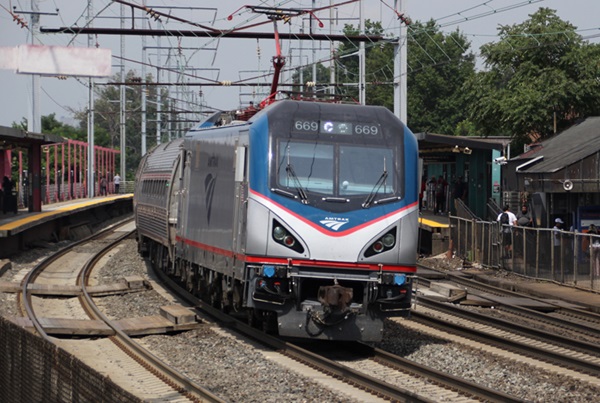
WASHINGTON — Amtrak received almost $200 million in the Federal Railroad Administration’s Consolidated Rail Infrastructure and Safety Improvements grants announced Monday, a list of awards highlighted by the more than $178 million for the restoration of Gulf Coast passenger service [see “Federal Railroad Administration awards more than $1.4 billion,” Trains News Wire, Sept. 24, 2023].
Other major awards received by Amtrak include up to $8.8 million for fencing along the Northeast Corridor; up to $8.8 million for a workforce development apprenticeship training program; and up to $1.826 million for a grade crossing improvement program in Mississippi and Louisiana, in partnership with Canadian National Railway and the two states to address crossings along the City of New Orleans route. Amtrak will provide a 20% non-federal match to all three projects.
“The CRISI grants announced today will help launch new and expanded service, advance critical safety and reliability improvements, and provide opportunities for the workforce, marking another big milestone as we continue to advance a new era of passenger rail,” Amtrak CEO Stephen Gardner said in a press release.
Amtrak said it had also supported grants by other entities which had received funding, including the Massachusetts Department of Transportation’s Springfield-Worcester line improvement project; the Virginia Passenger Rail Authority’s Franconia-Springfield bypass project; MARC’s Penn-Camden line connector; Birmingham Department of Transportation’s REDESIGN Alabama project; and the Capitol Corridor Joint Powers Authority’s Sacramento-Roseville third-track project.













Every form of transportation has subsidy. City mass transit, inter city passenger rail, Water freight, and Airline transportation are all subsidized by tax payers.
The vast majority of people in this country think that the fuel taxes (gas/diesel) pays for ALL road maintenance and new construction. Nothing could be further from the truth. Hasn’t been that way in over twenty-five years. Almost 40% of Federal highway monies come from either the general fund or freshly printed money from new programs.
Fuel taxes haven’t been raised to meet inflation since the early 1990’s, It’s getting worse because new car millage standards have increased, thus reducing money flowing into the fund. And if you bought an EV., NO money is flowing into the fund. To make highway trust fund solvent you would need to double the federal fuel tax, index it to inflation, then CHARGE EV owners a tax to use the roads and highways.
Rivers and harbors have to be dredged to accommodate the increasing size of ships. Shipping locks have to be rebuilt for larger barges. Fuel tax for shipping covers about 25% (maybe less) of this expense.
Federal government subsidizes passenger (Amtrak) and freight rail (mostly shortlines but major lines to some extent).
Finely Air Travel. If you think that the cost of an airline ticket covers everything, you are mistaken. If Average Joe/Jane that buys a ticket for $300 to $600 (depending on level of service, time of day, and day of week) thinks that’s the total cost to fly must be smoking Mary Jane. That doesn’t come close in covering the cost of the TSA, Air Traffic Control, and mandatory upgrades or expansion of the airports themselves. If that cost had to be paid by the user (instead of the government) ticket prices would be a lot higher, maybe 3 to 4 times what we pay for now.
At least here in Ohio some gas stations are putting the amount of taxes collected per gallon. And it’s broken down into what amount goes into what pocket. The Ohio Constitution does not allow fuel taxes to be used for anything other than highways. Which has been a stumbling block in other than highway funding.
Probably won’t result in any new equipment or routes. It’ll be peed away with ‘studies”
Good idea, Charles. How about we include, on the placard at the gas pump, the amount of subsidies, tax credits and corporate welfare the oil and gas producers receive.
ANSWER: Because there isn’t enough ink and materials to discose all the corporate welfare in this country.
Last year oil companies paid over 10 billion in taxes to the State of Texas. ExxonMobil paid 19 billion to the feds. Oil companies create wealth, not consume it like the government.
In other words, Amtrak is subsidized at the state, local and federal level from a number of different pots. So we don’t really know how much tax money supports that ticket we pay our own money for.
I’m not opposed to tax subsidy of Amtrak (or commuter rail, or aviation). I just want the cost to be out in the open.
Airline web sites, and soon enough every product we buy or service we use, purportedly discloses the carbon footprint or the carbon dioxide emissions or whatever, a useless statistic. How about a REAL number. Whenever you buy a ticket for a train or a bus or a subway, or those essential air services that where tickets sold don’t pay the cost of the pilot’s breakfast, have the ticket spit out the amount of subsidy.
I buy a train ticket Milwaukee to Chicago for $26.00. Have the total subsidy from all sources (capital recovery and operating subsidy) printed on the ticket. What would that number be? Maybe well over a hundred dollars. Someone else flies Cape Air from Nashville International to Owensboro (Kentucky) or Marion (Illinois). Someone pays $2.75 on the MBTA subway. Disclose the total subsidies.
Or I drive my Subaru up the gas pump. Have a placard on the pump disclosing the gas taxes I pay, AND the commensurate amount of highway money that comes out of the general fund and thus is a subsidy to the highway system.
Oh, and don’t even get me started on EV subsidies, tax credits, corporate welfare for those EV battery factories, and on and on and on and on.